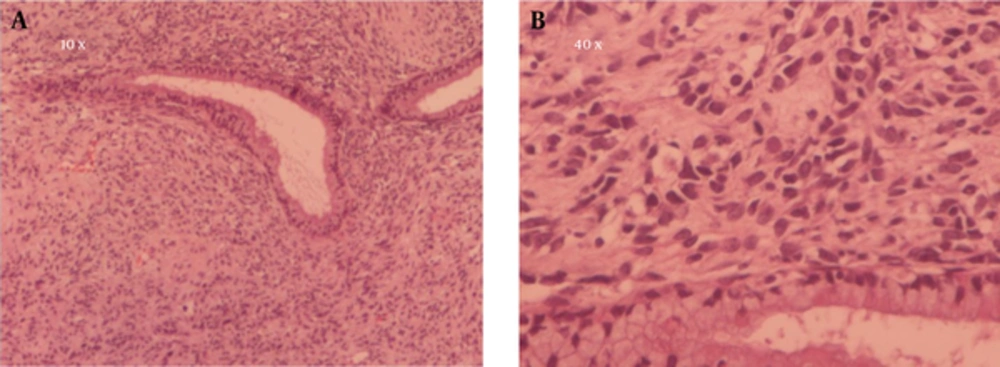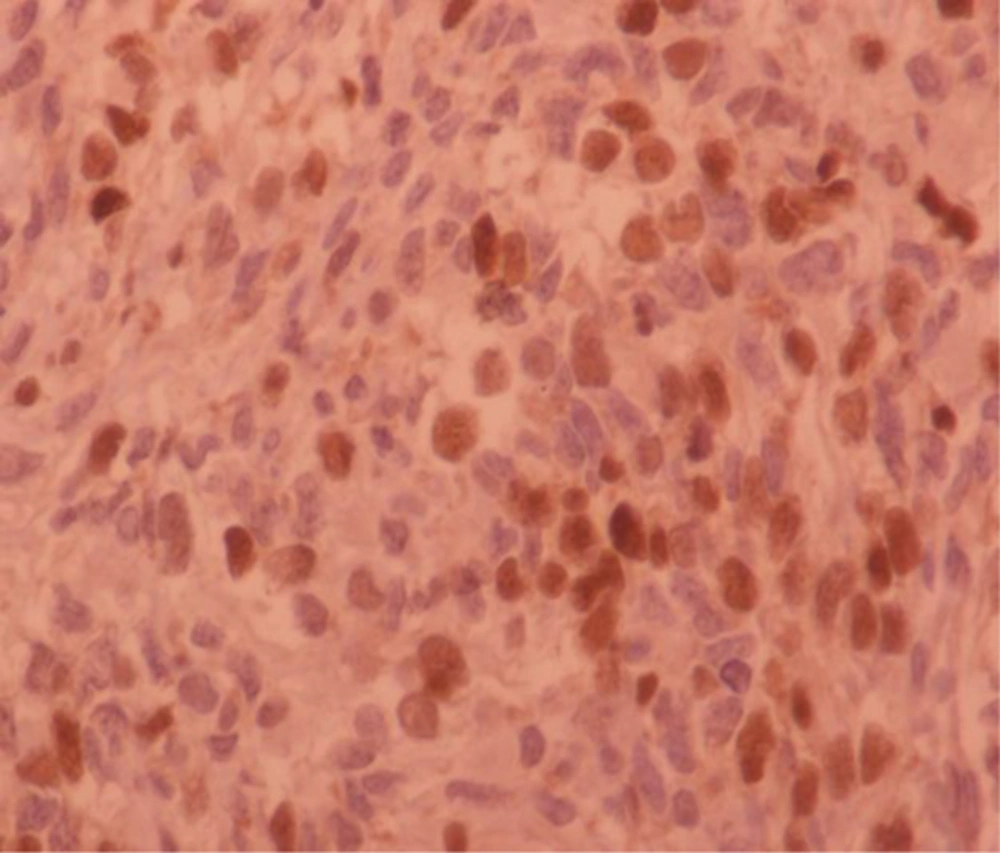1. Introduction
Rhabdomyosarcoma was a highly malignant soft tissue sarcoma which arised from embryonic muscle cells (1). It has known as the most common soft tissue sarcoma in childhood, accounting for about 3 to 4 % of all cases of childhood cancer. Approximately 350 new cases have diagnosed each year in patients younger than 20 years (2). Rhabdomyosarcoma was rare in adults, with soft-tissue sarcomas making up less than 1% of malignancies in adults and rhabdomyosarcoma accounting for 3% of all soft-tissue sarcomas (3). Male to female ratio was 1.5 to 1 and male had slightly better overall survival (4).
The head and neck were the most frequent (35 - 40%) sites of origin, followed by the genitourinary tract, extremities, trunk, retroperitoneum, and uncommon regions (e.g. intrathoracic, GI tract, perianal and anal regions) (5). One of the least common sites for rhabdomyosarcoma in the genitourinary tract is the uterine cervix (6).
Five major histologic subtypes of rhabdomyosarcoma have identified including embryonal, alveolar, botryoid embryonal, spindle cell embryonal, and anaplastic.
The embryonal subtype was the most common subtype in childhood, although there have been a few reports of this neoplasm in adult (7). Most were of the classic subtype, and the botryoid and spindle cell variants comprised 6 and 3 percent, respectively (8). Botryoid rhabdomyosarcoma is a subtype of embryonal rhabdomyosarcoma that could observe in the walls of hollow, mucosa lined structures such as vagina, bladder nasopharynx and rarely cervix and uterine fundus. It has resembled a bunch of grapes. Sarcoma botryoides normally has found in children under 8 years of age (9, 10). However cases of older women with this pathology have also reported (11).
Although adults with rhabdomyosarcoma had generally worse survival than children with similar tumors, cervical botyroid rhabdomyosarcoma, usually occurring in second decade has higher level of survival and better prognosis than vaginal lesions with peak of incidence in infants. The survival rate of vaginal and cervical lesions has reported to be of 96% and 60%, respectively (12).
2. Case Presentation
A 33-year-old woman, G2L2P2, presented with abnormal vaginal discharge. Gynecologic examination has revealed a cervical mass with grape-like feature protruding into vagina with posterior-superior vaginal wall involvement. She had normal menstrual cycles and her past medical history was unremarkable. Cervical mass biopsy has performed and pathologic examination was consistent with embryonal botryoid type rhabdomyosarcoma which has confirmed with pathologic review. Transvaginal sonography has shown a 38 × 27 × 60 mm cervical mass at inferior-posterior portion of cervix with superior vaginal wall infiltration. She has undergone the staging work up measurements including thoracic computed tomography (CT) scan, bone scan and bone marrow examination. In abdominopelvic magnetic resonance imaging (MRI), in addition of cervical mass, 2 suspicious pelvic lymph nodes have revealed. All other measurements were normal. Radical hysterectomy with lymph node debulking and ovarian preservation has performed. There was a grossly huge cervical mass protruding into vagina with surface irregularities measuring 10×10 cm. On sections, there was a gray tumor with spindle cell proliferation, measuring 8×5×2.5 cm. On microscopic examination, tumor has covered by attenuated epithelium with condensed neoplastic cells layer beneath epithelium (cambium layer) and consisted of the spindle shaped embryonal rhabdomyoblasts cells with eosinophilic cytoplasm and atypical nuclei. Final results have shown embryonal botryoid type rhabdomyosarcoma of cervix, consistent with the intergroup RMS study Group I. Ovaries, endometrium, parametrium, and follopian tubes were unremarkable. Pelvic lymph nodes pathology and intraabdominal fluid cytology were negative for malignancy. Lymphovascular invasion has identified. She has advised for adjuvant chemotherapy.
Based on medical ethics committee of Shahid Beheshti University of Medical Sciences, a written informed consent has obtained from the patient for publication of this manuscript and accompanying images.
3. Discussion
Genital tract has been the second most common site of embryonal rhabdomyosarcoma. It has happened in female genital tract in childhood period but rarely in female adults. cervical rhabdomyosarcoma usually has occurred in the second decade however few cases have reported in later ages. Shim et al. has reported a case of cervical embryonal rhabdomyosarcoma in a 52-year-old woman with vaginal bleeding and the feeling of a mass protruding from the introitus (3).
Kaushal et al. has reported a 44-year-old premenopausal female with embryonal rhabdomyosarcoma presented with complaints of bleeding per vagina and irregular menstruation (13).
Our case was a 33-year-old that has been older than the peak incidence age of cervical rhabdomyosarcoma. Presenting symptom was abnormal vaginal discharge.
Dehner et al. has examined 14 case of embryonal rhabdomyosarcoma, shown that the most of patients have presented with cervical mass in the range of 1.5 - 5 cm (14). Our case had a large mass measuring 6 cm.
The surgical treatment for cervical rhabdomyosarcoma could be conservative or radical surgery depending of patient parity and tumor extension. A 52-year-old case has reported with Shim et al., undergone radical abdominal hysterectomy with bilateral salpingo-oophorectomy, and bilateral pelvic lymph node (3). Most case has reported by Dehner et al., treated with local excision (14).
This case has reminded that embryonal rhabdomyosarcoma could occur in uncommon site and older female. Longer follow up of these cases has required due to lack of survival data for embryonal rhabdomyosarcoma of this site and age group.

